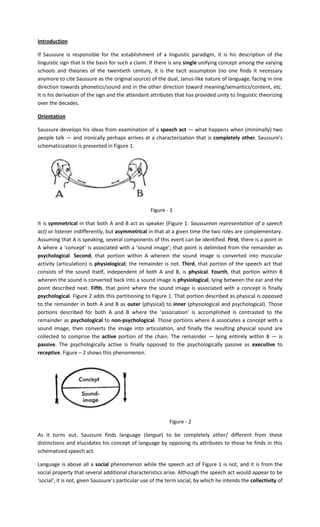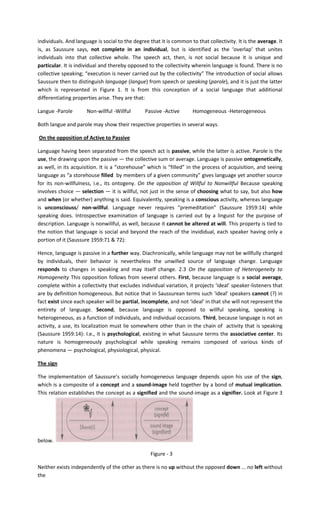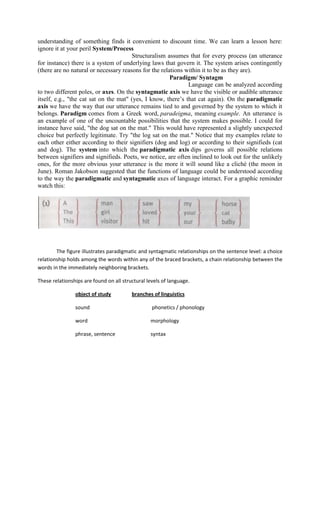Structuralism analyzes systems by examining the relations between their smallest elements. In linguistics, Ferdinand de Saussure pioneered the study of langue (language as a system) rather than parole (individual speech). He viewed langue as a system of arbitrary signs made up of a signifier and signified. Langue exists socially and unconsciously for speakers. It is defined relationally rather than by the content of its elements. Claude Levi-Strauss later applied structuralist principles to anthropology and myth studies. Structuralism examines deep unconscious structures rather than surface phenomena.
![Structuralism<br />Structuralism is a mode of thinking and a method of analysis practiced in 20th-century social sciences and humanities. Methodologically, it analyzes large-scale systems by examining the relations and functions of the smallest constituent elements of such systems, which range from human languages and cultural practices to folk tales and literary texts. <br />In the field of linguistics the structuralist work of Ferdinand de Saussure, undertaken just prior to World War I, long served as model and inspiration. Characteristic of structuralist thinking, Saussure's linguistic inquiry was centered not on speech itself but on the underlying rules and conventions enabling language to operate. In analyzing the social and collective dimension of language rather than individual speech, he pioneered and promoted study of grammar rather than usage, rules rather than expressions, models rather than data, \"
langue\"
(language) rather than \"
parole\"
(speech). Saussure was interested in the infrastructure of language that is common to all speakers and that functions on an unconscious level. His inquiry was concerned with deep structures rather than surface phenomena, and made no reference to historical evolution. In structuralist terminology, it was synchronic, existing now, rather than diachronic, existing and changing over time.<br />In the domain of anthropology and myth studies, the work done in the immediate post-World War II period by Claude Levi-Strauss introduced structuralist principles to a wide audience. Following the ideas of Saussure and of the Slavic linguists N. S. Trubetzkoy and Roman Jacobson, Levi-Strauss specified four procedures basic to structuralism. First, structural analysis examines unconscious infrastructures of cultural phenomena; second, it regards the elements of infrastructures as \"
relational,\"
not as independent entities; third, it attends single-mindedly to system; and fourth, it propounds general laws accounting for the underlying organizing patterns of phenomena. <br />In humanistic and literary studies, structuralism is applied most effectively in the field of \"
narratology.\"
This nascent discipline studies all narratives, whether or not they use language; myths and legends, novels and news accounts, histories, relief sculptures and stained-glass windows, pantomimes and psychological case studies. Using structuralist methods and principles, narratologists analyze the systematic features and functions of narratives, attempting to isolate a finite set of rules to account for the infinite set of real and possible narratives. Starting in the 1960s, the French critic Roland BARTHES and several other French narratologists popularized the field, which has since become an important method of analysis. <br />Because structuralism values deep structures over surface phenomena, it parallels, in part, the views of Marx and Freud, both of whom were concerned with underlying causes, unconscious motivations, and transpersonal forces, shifting attention away from individual human consciousness and choice. Like Marxism and Freudianism, therefore, structuralism furthers the ongoing modern diminishment of the individual, portraying the self largely as a construct and consequence of impersonal systems. Individuals neither originate nor control the codes and conventions of their social existence, mental life, or linguistic experience. As a result of its demotion of the person, or subject, structuralism is widely regarded as \"
anti-humanistic.\"
<br />Saussure envisaged a new discipline, a science of signs and sign language which he named \"
semiology,\"
and for which he believed structural linguistics could provide the principle methodology. The American philosopher C. S. PEIRCE, Saussure's contemporary, sketched a similar science labeled \"
semiotic.\"
In 1961, Levi Strauss situated structural anthropology within the domain of \"
semiology.\"
Increasingly, the terms \"
semiology\"
and SEMIOTICS came to designate a field of study that analyzes sign systems, codes, and conventions of all kinds, from human to animal and sign languages, from the jargon of fashion to the lexicon of food, from the rules of folk narrative to those of phonological systems, from codes of architecture and medicine to the conventions of myth and literature. The term semiotics has gradually replaced structuralism, and the formation of the International Association for Semiotic Studies in the 1980s has solidified the trend. <br /> Ferdinand de Saussure<br />Introduction<br />If Saussure is responsible for the establishment of a linguistic paradigm, it is his description of the linguistic sign that is the basis for such a claim. If there is any single unifying concept among the varying schools and theories of the twentieth century, it is the tacit assumption (no one finds it necessary anymore to cite Saussure as the original source) of the dual, Janus-like nature of language, facing in one direction towards phonetics/sound and in the other direction toward meaning/semantics/content, etc. It is his derivation of the sign and the attendant attributes that has provided unity to linguistic theorizing over the decades.<br />Orientation<br />Saussure develops his ideas from examination of a speech act — what happens when (minimally) two people talk — and ironically perhaps arrives at a characterization that is completely other. Saussure’s schematicization is presented in Figure 1. <br />Figure - 1<br />It is symmetrical in that both A and B act as speaker (Figure 1: Saussurean representation of a speech act) or listener indifferently, but asymmetrical in that at a given time the two roles are complementary. Assuming that A is speaking, several components of this event can be identified. First, there is a point in A where a ‘concept’ is associated with a ‘sound image’; that point is delimited from the remainder as psychological. Second, that portion within A wherein the sound image is converted into muscular activity (articulation) is physiological; the remainder is not. Third, that portion of the speech act that consists of the sound itself, independent of both A and B, is physical. Fourth, that portion within B wherein the sound is converted back into a sound image is physiological, lying between the ear and the point described next. Fifth, that point where the sound image is associated with a concept is finally psychological. Figure 2 adds this partitioning to Figure 1. That portion described as physical is opposed to the remainder in both A and B as outer (physical) to inner (physiological and psychological). Those portions described for both A and B where the ‘association’ is accomplished is contrasted to the remainder as psychological to non-psychological. Those portions where A associates a concept with a sound image, then converts the image into articulation, and finally the resulting physical sound are collected to comprise the active portion of the chain. The remainder — lying entirely within B — is passive. The psychologically active is finally opposed to the psychologically passive as executive to receptive. Figure – 2 shows this phenomenon.<br />Figure - 2<br />As it turns out, Saussure finds language (langue) to be completely other/ different from these distinctions and elucidates his concept of language by opposing its attributes to those he finds in this schematized speech act.<br />Language is above all a social phenomenon while the speech act of Figure 1 is not, and it is from the social property that several additional characteristics arise. Although the speech act would appear to be ‘social’, it is not, given Saussure’s particular use of the term social, by which he intends the collectivity of individuals. And language is social to the degree that it is common to that collectivity. It is the average. It is, as Saussure says, not complete in an individual, but is identified as the ‘overlap’ that unites individuals into that collective whole. The speech act, then, is not social because it is unique and particular. It is individual and thereby opposed to the collectivity wherein language is found. There is no collective speaking; “execution is never carried out by the collectivity” The introduction of social allows Saussure then to distinguish language (langue) from speech or speaking (parole), and it is just the latter which is represented in Figure 1. It is from this conception of a social language that additional differentiating properties arise. They are that: <br />Langue -Parole Non-willful -Willful Passive -Active Homogeneous -Heterogeneous<br />Both langue and parole may show their respective properties in several ways.<br /> On the opposition of Active to Passive<br />Language having been separated from the speech act is passive, while the latter is active. Parole is the use, the drawing upon the passive — the collective sum or average. Language is passive ontogenetically, as well, in its acquisition. It is a “storehouse” which is “filled” in the process of acquisition, and seeing language as “a storehouse filled by members of a given community” gives language yet another source for its non-willfulness, i.e., its ontogeny. On the opposition of Willful to Nonwillful Because speaking involves choice — selection — it is willful, not just in the sense of choosing what to say, but also how and when (or whether) anything is said. Equivalently, speaking is a conscious activity, whereas language is unconsciouss/ non-willful. Language never requires “premeditation” (Saussure 1959:14) while speaking does. Introspective examination of language is carried out by a linguist for the purpose of description. Language is nonwillful, as well, because it cannot be altered at will. This property is tied to the notion that language is social and beyond the reach of the invididual, each speaker having only a portion of it (Saussure 1959:71 & 72): <br />Hence, language is passive in a further way. Diachronically, while language may not be willfully changed by individuals, their behavior is nevertheless the unwilled source of language change. Language responds to changes in speaking and may itself change. 2.3 On the opposition of Heterogeneity to Homogeneity This opposition follows from several others. First, because language is a social average, complete within a collectivity that excludes individual variation, it projects ‘ideal’ speaker-listeners that are by definition homogeneous. But notice that in Saussurean terms such ‘ideal’ speakers cannot (?) in fact exist since each speaker will be partial, incomplete, and not ‘ideal’ in that she will not represent the entirety of language. Second, because language is opposed to willful speaking, speaking is heterogeneous, as a function of individuals, and individual occasions. Third, because language is not an activity, a use, its localization must lie somewhere other than in the chain of activity that is speaking (Saussure 1959:14): I.e., it is psychological, existing in what Saussure terms the associative center. Its nature is homogeneously psychological while speaking remains composed of various kinds of phenomena — psychological, physiological, physical.<br />The sign<br />The implementation of Saussure’s socially homogeneous language depends upon his use of the sign, which is a composite of a concept and a sound-image held together by a bond of mutual implication. This relation establishes the concept as a signified and the sound-image as a signifier. Look at Figure 3 below. <br />Figure - 3<br />Neither exists independently of the other as there is no up without the opposed down ... no left without the<br />contrary right. Both derive their existence relationally, rather than by their own content.<br />A depiction of the sign relation.<br />The sign exists as a psychological reality independent of its manifestation, e.g. “phonemes ... which suggest[...] verbal activity ... is applicable to the spoken word only” And their content, but from their place in a system, by their opposition to one another. The matter/material that realizes them or the opposition is irrelevant. The separation of the signs of language/langue from material expression<br />implies a second property of signs, the famed arbitrariness of the bond between the signifier and signified. Given that language/langue exists independently from its manifestation and that a signifier and signified take their status from that mutual relation, it matters not what signifier bonds with what signified. This systemic arbitrariness is supported by the empirical observation that one cannot reason from sound-to-meaning nor from meaning to sound.<br />Language/langue and the theory<br />Language/langue is a system of arbitrarily constituted signs, defined by their opposition to other signs. Language is abstract, but it is not an abstraction. 10 Saussure takes care to emphasize the reality, the existence of the system of signs. Saussure adopts a realist’s position towards his object of study; he advocates a God’s-truth belief in the actuality of langue and not a hocus-pocus attitude. In denying the possibility of arriving at the system by means of a series of analyses, Saussure rejects an operational kind of theory and proposes a theory which is explanatory. There are several motivations for his position. First, because language/langue has an abstract (though real) existence and only an arbitrary association with its realization, it is not possible to reason from sound-image (or from concepts) to the sign.11 It is the (system of) sign(s) which order(s) and shape(s) sound-images and concepts; and without prior knowledge of the sign, one cannot know what portions to operate upon. The segmentation is not a given. <br />Second, an operational discovery of the elements of language/langue would lead to an abstraction. Consideration of the French alternation between mwa and mwaz ‘month’, and attempting to establish a signifier would yield an abstraction which is the ‘link’ between the two, but is neither, and which has no status in parole, nor in langue .Third, the discovery techniques would yield a list and not a system, thus missing the structural essence of language/langue. And fourth, signs match no entities of a fixed size in speaking. They are not uniquely equivalent to ‘words’. Beginning with one or the other, then, will not produce consistent identification of the signs of the language system.<br />The theory is therefore explanatory. Saussure underscores — implicitly — that the explanation is a deductive one, not historical, and seeks to establish a synchronic linguistics. The explanation is not one of cause-and-effect, that attributes to the natural sciences but the ‘weaker’ deductive one. The system which Saussure suggests exists independent of time ... it is unchanging ... thus cause-and-effect explanations can have no home in language/langue. Given a sign relation as in Figure 3, the replacement of the content of the signifier, or the replacement of the signified will have no effect upon the system as long as the system, i.e., the structural relations remain unaltered (Saussure 1959:94): One can see additional properties in language change which set the history of language off from atemporal language and which avoid historical explanations. First, change affects only one term of the sign. <br />The history of language does not deal with signs, and “to try to unite such dissimilar facts in the same discipline would be certainly a fanciful undertaking” The patterns of language are not those of change Second, change like speaking is active; both are events. There will be no ‘events’ in language/langue, only “the momentary arrangement of terms”.Implicit in this is that whatever pattern Saussure adduces for language/langue, it will be static and taxonomic.<br />An Exercise in Structuralism Synchrony/Diachrony, Paradigm/Syntagm are the terms we have already discussed. A distinction must be made between the way languages appear to us (as changing through time) and as they are at any given time (governed by systematic relations not affected by time passing). Synchronic linguistics is supposed to study the systematic aspects of language rather than the diachronic aspects. This will not be the only occasion where an attempt at a scientific understanding of something finds it convenient to discount time. We can learn a lesson here: ignore it at your peril System/Process Structuralism assumes that for every process (an utterance for instance) there is a system of underlying laws that govern it. The system arises contingently (there are no natural or necessary reasons for the relations within it to be as they are). Paradigm/ Syntagm Language can be analyzed according to two different poles, or axes. On the syntagmatic axis we have the visible or audible utterance itself, e.g., \"
the cat sat on the mat\"
(yes, I know, there’s that cat again). On the paradigmatic axis we have the way that our utterance remains tied to and governed by the system to which it belongs. Paradigm comes from a Greek word, paradeigma, meaning example. An utterance is an example of one of the uncountable possibilities that the system makes possible. I could for instance have said, \"
the dog sat on the mat.\"
This would have represented a slightly unexpected choice but perfectly legitimate. Try \"
the log sat on the mat.\"
Notice that my examples relate to each other either according to their signifiers (dog and log) or according to their signifieds (cat and dog). The system into which the paradigmatic axis dips governs all possible relations between signifiers and signifieds. Poets, we notice, are often inclined to look out for the unlikely ones, for the more obvious your utterance is the more it will sound like a cliché (the moon in June). Roman Jakobson suggested that the functions of language could be understood according to the way the paradigmatic and syntagmatic axes of language interact. For a graphic reminder watch this:<br />The figure illustrates paradigmatic and syntagmatic relationships on the sentence level: a choice relationship holds among the words within any of the braced brackets, a chain relationship between the words in the immediately neighboring brackets.<br />These relationships are found on all structural levels of language.<br />object of study branches of linguistics<br />sound phonetics / phonology<br />word morphology<br />phrase, sentence syntax<br /> <br />](https://image.slidesharecdn.com/sem2-110513110423-phpapp01/85/structuralism-1-320.jpg)



